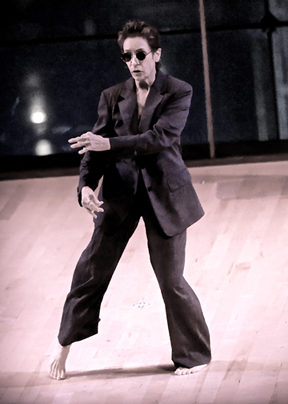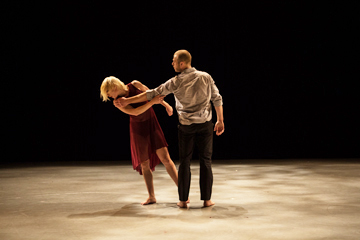Dance: Performers and Presenters
By Dawn Lille
ART TIMES February 2015 online
 Paula Josa-Jones in SPEAK |
The Association of Performing Arts Presenters, known as APAP, holds its yearly convention every January in New York City. This large gathering can be regarded with exhilaration, trepidation, or exhaustion, depending upon one’s purpose, stamina or location at the many performing venues in the city or, this year, at the Hilton. Here could be found booths of various booking agents, filled with flyers, DVDs and CDs of the many dance and music groups across the country (and a few from outside) hoping to find work in the near future.
The ideal situation from the dancer’s point of view is to have an opportunity to perform and be seen by a number of presenters who will be impressed enough to book them. Any way you look at it, it is the merchandising of the art, which is an absolute necessity.
It is difficult to write a critical review of most of these performances because they are brief (7 to 10 minutes) and it was possible to see over 30 companies in one day! But it does offer an opportunity for a quick glimpse of often-unfamiliar groups.
An invitation from one company to see them in the Appel Room at Jazz at Lincoln Center lured me to this jazz space and I stayed for some time. This series, presented by Jodi Kaplan and Associates, was called Booking Dance Festival, NYC. It was difficult to concentrate on the dancers performing in front of the glass wall, behind which one could see the lights of cars going east and west on 59th Street, not to mention all the silhouetted buildings. This is a great venue for jazz, but very poor for most dances if you wish to really see it.
The “clunking” of people walking in and out during a performance and the lack of any program or handout listing the choreographers, music or dancers was most disrespectful of all. The companies were listed according to hourly time segments, with an often- blurred announcement made before each showing. This is an art form, not a kitchen gadget pop up.
Some of the offerings were elaborately costumed and overly dramatic, but with little dance; others reminiscent of a good college piece. But of those seen, three stood out.
 L.A. Contemporary Dance Company Photo by Jaqlin Medlock, courtesy of APAP at Peridance |
Gaspard & Dancers, based in Durham, North Carolina, is under the artistic leadership of Gaspard Louis, a dancer and choreographer who founded the company in 2009. It was difficult to hear the name of the piece as it boomed over the loudspeaker, but these young, flexible, high leaping dancers embraced the air with joy. There were recognizable phrases of African dance that were then expanded and developed into light, free, space -devouring movements that were simultaneously strong and buoyant.
Abarukas is a contemporary hip-hop company founded in 2012 by Yoshito Sakuraba, whose own eclectic background includes Graham training. His well -trained dancers, international in background, displayed a forceful and controlled technique in choreography that began on the floor, where they created some grotesque body shapes. The brief excerpt exhibited daring, risk -taking movements not limited to hip-hop, accompanied by an interesting score. I look forward to seeing them perform a complete work.
Paula Josa-Jones has been creating and performing for a long time, often in New England, but I have never experienced her work. She is really a theater artist who teaches, coaches, works with horses, writes, choreographs and is interested in film. The solo she performed, filled with concentrated dramatic energy and subtle minute details, went through evolving stages of thinking and being, bringing to mind the dancer Daniel Nagrin. Unfortunately, part of her dance was marred by the noisy movements of the audience. I would like to see her work again.
The showing the next day in the Capezio Theater at Peridance was entirely different. It was professional; people moved in and out only between dances, and there was a complete printed program. There were ten pieces on each of two different programs, A and B, both shown on two days.
The afternoon began with Alice in Wonderland by the Bellydance Evolution Company and ended with La Paloma by the Mystic Ballet of Connecticut. In Alice there were many sequined costume changes for the 15 female dancers (there was one male) who were called upon to use their well -toned muscles in many different rhythms, trying to present the basic story. They used umbrellas and became mushrooms, which the children in the audience loved. The colorfully costumed Mystic Ballet work seemed to be a satire on S and M, among other things. But this excerpt was, at best, confusing in its attempt at humor.
Elsco Dance, formed in 2012 and based in NYC, is a young group devoted to both commercial and concert dance, a difficult mission to maintain artistically. Their selection from Bottom of the River, choreographed by their director Ellenore Scott, displayed strong, full bodied, visceral moves in a work that followed the music note for note, a tendency that weakened it.
It was good to see the L.A, Contemporary Dance Company, who had performed the previous evening but were blocked from view. Unravel is a duet choreographed by the group’s founder, Kate Hutter. A ten -year old company based in Los Angeles, it tries to attract local artists in building a dance community.
Genevieve Carson and Nicholas Heitzeberg alternated support of each other in this duet that indicated the ebb and flow of their relationship and engaged the viewer throughout.
The Peridance Contemporary Company, in an except from Igal Perry’s Infinity, featured four couples, well trained and rehearsed, in a flowing, carefully crafted and polished presentation that felt grounded. This takes time and some of the other companies may get there eventually.
APAP is, perhaps, a necessary process to bring dance performance to an audience, but it is very hard on both the dance companies and those who choose to present them.
dawnlille@aol.com
